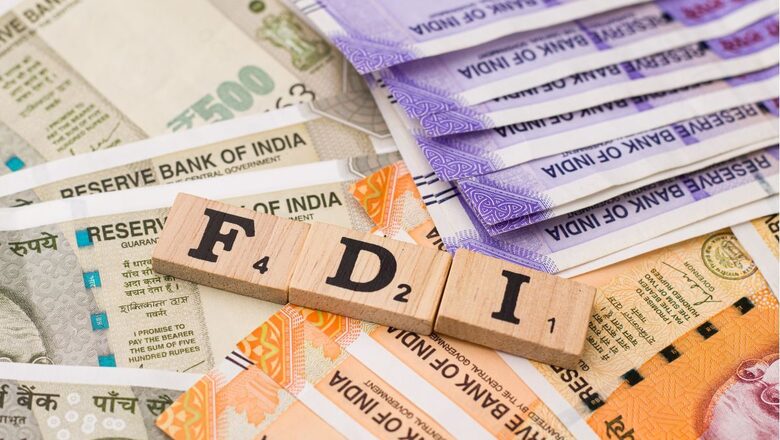
views
Foreign direct investment into India is likely to gather momentum in 2024 as healthy macroeconomic numbers, better industrial output as well as attractive PLI schemes will attract more overseas players amid geopolitical headwinds and tighter interest rate regimes globally.
To ensure that India remains an attractive and investor-friendly destination, Department for Promotion of Industry and Internal Trade (DPIIT) Secretary Rajesh Kumar Singh said the government reviews FDI policy on an ongoing basis and makes changes from time to time after having extensive consultations with stakeholders.
Also Read: India’s Economic Growth To Boost Demand Of Corporates: Fitch Ratings
In the January-September period this year, Foreign Direct Investment (FDI) into the country declined 22 per cent to USD 48.98 billion. The inflow was at USD 62.66 billion in the year-ago period.
”However, we are broadly in line with the overall trends of FDI growth. FDI inflows from 2014-23 period is about USD 596 billion, which is about double than what India received during 2005-14. The trend is positive and India is still the preferred destination for foreign players,” Singh told PTI.
According to him, Production Linked Incentive (PLI) schemes for sectors like pharma, food processing, and medical appliances have started yielding fruits and are attracting foreign investors.
“Many of these sectors have seen a jump in FDI,” Singh said.
He said the major reasons for the shortfall in FDI inflows could include the threat of global recession, economic crisis due to the Russia-Ukraine conflict and protectionist measures.
A decline in real GDP growth rates of Singapore, the USA and the UK could also be a factor as these countries are major sources for FDI into India, he added.
Singh also emphasised that India continues to open up its economy to global investors by raising FDI limits, removing regulatory barriers, developing infrastructure and improving the business environment.
Experts also opined that despite the global challenges, India is still the preferred investment destination.
Steps taken to promote ease of doing business, availability of skilled manpower, natural resources, liberal FDI policy, huge domestic market and PLI schemes are the reasons for optimism concerning foreign fund inflows in 2024, they said.
According to UNCTAD’s World Investment Report 2023, the number of greenfield investment projects announced in developing countries increased by 37 per cent.
“This is a positive sign for investment prospects in industry and infrastructure,” it said.
Rumki Majumdar, an economist at consultancy Deloitte India, said the slowdown in capital flows has been more a function of tightening global liquidity and geopolitical uncertainties.
“But soon the world will recognise the strength of the fundamentals India has and India will see capital flows rising,” she said.
Majumdar said there is a genuine interest among global investors to tap into the potential of India and be a part of the growth journey that the country is likely to see over the decade.
Anindya Ghosh, partner at law firm IndusLaw, said it needs to be noted that global FDI has also dropped by a considerable margin and India can take some sense of comfort from the fact that it is not the only country bearing the wrath of the recent economic downturn.
“While there has been a lot of concerns about the decline in FDI in India recently, statistics indicate that FDI inflows might witness a modest increase in the year 2024,” Ghosh said.
As per the National Statistical Office (NSO), the Indian economy grew 7.7 per cent in the first half of 2023-24.
The country’s foreign exchange reserve is above USD 600 billion and industrial production accelerated to a 16-month high of 11.7 per cent in October, mainly due to double-digit growth in the output of manufacturing, power and mining sectors.
Also, PLI schemes that seek to boost India’s manufacturing capabilities and exports have been announced for 14 sectors. The total outlay for the schemes is Rs 1.97 lakh crore and the sectors covered include white goods, telecom and auto components.
During the period between April 2000 to September 2023, total FDI into India reached USD 953.14 billion.
About one-fourth of the FDI came through the Mauritius route during the period under review.
It was followed by Singapore (23 per cent), the US (9 per cent), the Netherlands (7 per cent), Japan (6 per cent) and the UK (5 per cent). The UAE, Germany, Cyprus, and Cayman Islands accounted for 2 per cent each.
The key sectors that attracted the maximum FDI in India include the services segment, computer software and hardware, telecommunications, trading, construction development, automobile, chemicals and pharmaceuticals.
FDI is allowed through the automatic route in most of the sectors while in areas such as telecom, media, pharmaceuticals and insurance, government approval is required for foreign investors.
Under the government approval route, a foreign investor has to take a prior nod of the ministry or department concerned whereas under the automatic route, an overseas investor is only required to inform the Reserve Bank of India (RBI) after the investment is made.
At present, FDI is prohibited in certain sectors. They are lottery, gambling and betting, chit funds, Nidhi company, real estate business, and manufacturing of cigars, cheroots, cigarillos and cigarettes using tobacco.
FDI is important as India will require huge investments in the coming years for its infrastructure sector to boost growth. Healthy foreign inflows also help in maintaining the balance of payments and the value of the rupee.




















Comments
0 comment